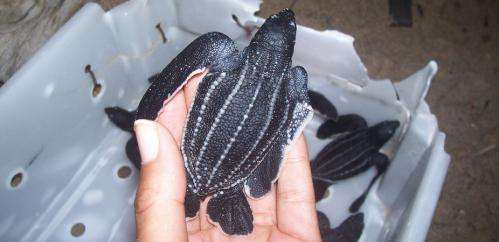Australian endangered species: Leatherback Turtle

Leatherback turtles (Dermochelys coriacea) are the largest, oldest and most widely distributed of the world's marine turtles.
Its appearance alone distinguishes the leatherback from its relatives: shell-less and bluish black in colour, with seven fleshy ridges along its back, and dappled all over with white spots. It is the only extant member of the ancient Dermochelyidae family, which first appeared around 100 million years ago.
Adult leatherbacks can grow to lengths of up to two meters and weigh as much as 700kg. In addition to its great size, the leatherback also undertakes the longest migration of any marine turtle, swimming on average 6,000km between feeding and nesting grounds.
Their diet consists almost entirely of jellyfish but also includes tunicates (relatives of sea squirts) and other soft-bodied invertebrates. In pursuing prey, leatherbacks can dive to depths exceeding 1,000m—a part of the ocean beyond the physiological limits of all other diving animals except beaked whales and sperm whales. Like these mammals, leatherbacks have adaptations to survive the lower temperatures and crushing pressures of these deep dives.
Leatherbacks can be found in all of the world's tropical and temperate oceans, and have been recorded in frigid sub-polar waters far outside the ranges of other marine turtles.
In Australia, leatherbacks forage in coastal waters around much of the country. Regular sightings occur in Western Australia, the Gulf of Carpentaria, eastern Australia and the cooler waters of southern Australia.
Leatherbacks nest sporadically in Australia, particularly in the Northern Territory. No nesting has been recorded in eastern Australia since 1996. There are no significant Australian rookeries, as nesting in the western Pacific region is concentrated in neighbouring countries such as Indonesia, Papua New Guinea and the Solomon Islands.
Most of the world's leatherback turtles live in the Atlantic Ocean. The world's largest nesting population is in Gabon, in western Africa.
Status
There are seven different populations of leatherback turtles, determined by genetic and migratory studies. Each of these vary in size, range, status and trends.
There are large populations in the Atlantic Ocean, and the north west Atlantic population is increasing.
But the Pacific Ocean populations have declined by over 80% in the past 30 years. In an extreme case of prolonged egg harvest and poor management of turtle bycatch, the number of nesting females at Terengganu, Malaysia declined from over 3,000 in 1968 to just two in 1993. This population has not recovered and is not expected to do so.
The IUCN is currently reviewing the global status of the leatherback turtle. In Australia, the EPBC Act classifies the leatherback as endangered.
Threats
The leatherback faces myriad threats throughout its range. Decades of consumption such as the collection of eggs for food and use as aphrodisiacs have nearly wiped out leatherbacks in Indonesia, Mexico and Costa Rica.
Large numbers of leatherbacks are also captured incidentally in commercial fisheries. Leatherback foraging habitat often overlaps with that of valuable pelagic fish species, such as tuna and swordfish. As a result, high levels of adult capture and mortality in these fisheries pose a grave threat to populations. Entanglement in discarded nets and lines, or "ghost fishing", is a significant but understudied problem.
Plastic pollution of the world's oceans is a ubiquitous and pervasive threat to leatherback turtles, which mistake floating plastic bags and other debris for jellyfish. In 2009, a scientific study found plastic debris in one third of leatherback turtle necropsies across the globe. Leatherbacks are especially at risk for eating plastic, which is carried by ocean currents to locations where the turtles feed.
Further threats to leatherbacks include loss of nesting beaches to coastal development, light pollution, nest predation by feral animals and continued illegal egg harvest.
Strategy
Conserving leatherbacks will require action from many different nations across the globe. Thankfully, their situation has not gone unnoticed and efforts are already underway in several countries.
For example, in Costa Rica, the Leatherback Trust is a non-profit foundation that works to engage the community and protect nests at crucial beaches in Las Baulas National Park. Since its inception, poaching of eggs has been eliminated within the park.
In 2012, the US National Marine Fisheries Service designated nearly 44,000 square km of critical habitat area for foraging leatherbacks off the west coast of the United States. Although this population nests in the western Pacific, the adults feed off the US coast, and are often caught as bycatch in gillnet and longline fisheries.
In the early 2000s, governments and NGOs helped establish community-based conservation in Papua New Guinea, West Papua in Indonesia, Solomon Islands and Vanuatu. These projects have gathered data that are essential for managing leatherbacks in their key Pacific nesting grounds. These projects need ongoing support.
In Australia, leatherbacks are protected under state and Commonwealth legislation, and commercial fisheries are working to reduce leatherback bycatch by implementing bycatch and discarding workplans. All commercial fishermen are legally obligated to report any interaction between leatherbacks and fishing gear to the relevant management authority.
Conclusion
The status of the leatherback turtle is unique for each population and varies across the globe, from healthy in the Atlantic to seriously declining in the Pacific. There is hope in the knowledge that key governments in the Pacific take the issue seriously. Perhaps most notably, the involvement of local communities in conservation efforts augurs a better future for the leatherback.
Source: The Conversation
This story is published courtesy of The Conversation (under Creative Commons-Attribution/No derivatives).
![]()
















